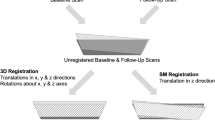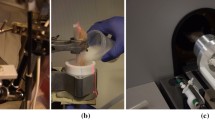Abstract
Over the last several years magnetic resonance (MR) imaging has emerged as a means of measuring in vivo 3D trabecular bone structure. In particular, MR based diagnosis could be used to complement standard bone mineral density (BMD) methods for assessing osteoporosis and evaluating longitudinal changes. The aim of this study was to demonstrate the feasibility of using the 3D-LSGA technique for the evaluation of trabecular bone structure of high-resolution MR images, particularly for assessing longitudinal changes, in vivo. First, the reproducibility of topological 3D-LSGA based measurements was evaluated in a set of seven volunteers, and coefficients of variations ranged from 3.5% to 6%. Second, high-resolution MR images of the radius in 30 postmenopausal women from a placebo controlled drug study (Idoxifene), divided into placebo (n=9) and treated (n=21) groups, were obtained at baseline (BL) and after 1 year of treatment (follow-up, FU). In addition, dual X-ray absorptiometry (DXA) measures of BMD were obtained in the distal radius. Standard morphological measurements based on the mean intercept length (MIL) technique as well as 3D-LSGA based measurements were applied to the 3D MR images. Significant changes from BL to FU were detected, in the treated group, using the topological 3D-LSGA based measurements, morphological measures of volume of connected trabeculae and App Tb.N from MIL analysis. The duration of the study was short, and the number of patients remaining in the study was small, hence these results cannot be interpreted with regard to a true therapeutic response. Furthermore, the site (wrist) and the drug (idoxifene) are not optimal for follow-up study. However, this paper demonstrated the feasibility of using 3D-LSGA based evaluation coupled with in vivo high-resolution MR imaging as a complementary approach for the monitoring of trabecular bone changes in individual subjects.




Similar content being viewed by others
References
Pothuaud L, Majumdar S (2004) Assessment of trabecular bone structure and bone quality using magnetic resonance imaging. In: Langton CM, Njeh CF (eds) The physical measurement of bone (in press)
Link TM, Saborowski Kisters K, Kempkes M et al. (2002) Changes in calcaneal trabecular bone structure assessed with high-resolution MR imaging in patients with kidney transplantation. Osteoporos Int 13:119–129
Wehrli FW, Hwang SN, Ma J et al. (1998) Cancellous bone volume and structure in the forearm: noninvasive assessment with MR microimaging and image processing [published erratum appears in Radiology 1998, 207:833]. Radiology 206:347–357
Hwang SN, Wehrli FW (2002) Subvoxel processing: a method for reducing partial volume blurring with application to in vivo MR images of trabecular bone. Magn Reson Med 47:948–957
Majumdar S, Genant HK, Grampp S et al. (1997) Correlation of trabecular bone structure with age, bone mineral density, and osteoporotic status: in vivo studies in the distal radius using high resolution magnetic resonance imaging. J Bone Miner Res 12:111–118
Vieth V, Link TM, Lotter A et al. (2001) Does the trabecular bone structure depicted by high-resolution MRI of the calcaneus reflect the true bone structure? Invest Radiol 36:210–217
Pothuaud L, Laib A, Levitz P et al. (2002) 3D-line skeleton graph analysis of high-resolution magnetic resonance images: a validation study from 34-μm-resolution micro-computed tomography. J Bone Miner Res 17:1883–1895
Majumdar S, Kothari M, Augat P et al. (1998) High-resolution magnetic resonance imaging: three-dimensional trabecular bone architecture and biomechanical properties. Bone 22:445–454
Beuf O, Newitt DC, Mosekilde L et al. (2001) Trabecular structure assessment in lumbar vertebrae specimens using quantitative magnetic resonance imaging and relationship with mechanical competence. J Bone Miner Res 16:1511–1519
Newitt DC, van Rietbergen B, Majumdar S (2002) Processing and analysis of in vivo high-resolution MR images of trabecular bone for longitudinal studies: reproducibility of structural measures and micro-finite element analysis derived mechanical properties. Osteoporos Int 13:278–287
Majumdar S, Link TM, Augat P et al. (1999) Trabecular bone architecture in the distal radius using magnetic resonance imaging in subjects with fractures of the proximal femur. Magnetic Resonance Science Center and Osteoporosis and Arthritis Research Group. Osteoporos Int 10:231–239
Link TM, Majumdar S, Augat P et al. (1998) In vivo high resolution MRI of the calcaneus: differences in trabecular structure in osteoporosis patients. J Bone Miner Res 13:1175–1182
Laib A, Newitt DC, Lu Y et al. (2002) New model-independent measures of trabecular bone structure applied to in vivo high-resolution MR images. Osteoporos Int 13:130–136
Pothuaud L, Newitt DC, Majumdar S (2001) Trabecular bone microarchitecture derived from high-resolution MRI of the ultradistal radius: relationship to osteoporotic status. Twenty-Third Annual Meeting of the ASBMR, Phoenix, Ariz., USA, M112
Newitt DC, Majumdar S, Van Rietbergen B et al. (2002) In vivo assessment of architecture and micro-finite element analysis derived indices of mechanical properties of trabecular bone in the radius. Osteoporos Int 13:6–17
Link TM, Lotter A, Beyer F et al. (2000) Changes in calcaneal trabecular bone structure after heart transplantation: an MR imaging study. Radiology 217:855–862
van Rietbergen B, Majumdar S, Newitt DC et al. (2002) High-resolution MRI and micro-FE for the evaluation of changes in bone mechanical properties during longitudinal clinical trials: application to calcaneal bone in postmenopausal women after one year of idoxifene treatment. Clin Biomech 17:81–88
Pothuaud L, Porion P, Lespessailles E et al. (2000) A new method for three-dimensional skeleton graph analysis of porous media: application to trabecular bone microarchitecture. J Microsc 199:149–161
http://www.hologic.com/prod-bd/pdf/spec-4500.pdf
Hildebrand T, Ruegsegger P (1997) A new method for the model-independent assessment of thickness in three-dimensional images. J Microsc 185:67–75
Day JS, Ding M, Odgaard A et al. (2000) Parallel plate model for trabecular bone exhibits volume fraction-dependent bias. Bone 27:715–720
Hildebrand T, Laib A, Müller R et al. (1999) Direct three-dimensional morphometric analysis of human cancellous bone: microstructural data from spine, femur, iliac crest, and calcaneus. J Bone Miner Res 14:1167–1174
Wehrli FW, Gomberg BR, Saha PK et al. (2001) Digital topological analysis of in vivo magnetic resonance microimages of trabecular bone reveals structural implications of osteoporosis. J Bone Miner Res 16:1520–1531
Pothuaud L, van Rietbergen B, Mosekilde L et al. (2002) Combination of topological parameters and bone volume fraction better predicts the mechanical properties of trabecular bone. J Biomech 35:1091–1099
Pothuaud L, Levity P, Benhamou CL (2001) Simulation of osteoporosis bone changes: effects on the degree of anisotropy. Adv Exp Med Biol 496:111–121
Pothuaud L, van Rietbergen B, Charlot C et al. (2004) A new computational efficient approach for trabecular bone analysis using beam models generated with skeletonized graph technique. Comp Meth Biomech Biomed Engng 1 (accepted)
Acknowledgements
The authors wish to thank Dr. Charles Chesnut at the University of Washington (UW) and Drs. Harry Genant and Steve Harris at the University of California, San Francisco (UCSF) for their previous assistance in the development of the longitudinal study. The present work was supported by grant NIH-RO1-AG17762.
Author information
Authors and Affiliations
Corresponding author
Rights and permissions
About this article
Cite this article
Pothuaud, L., Newitt, D.C., Lu, Y. et al. In vivo application of 3D-line skeleton graph analysis (LSGA) technique with high-resolution magnetic resonance imaging of trabecular bone structure. Osteoporos Int 15, 411–419 (2004). https://doi.org/10.1007/s00198-003-1563-4
Received:
Accepted:
Published:
Issue Date:
DOI: https://doi.org/10.1007/s00198-003-1563-4




